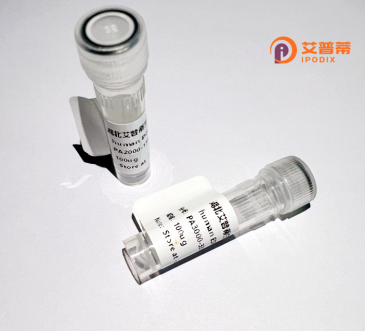
| 纯度 | >90%SDS-PAGE. |
| 种属 | Human |
| 靶点 | CN5H6.4 |
| Uniprot No | Q6ICE7 |
| 内毒素 | < 0.01EU/μg |
| 表达宿主 | E.coli |
| 表达区间 | 1-101aa |
| 氨基酸序列 | MELESTIFRDEDKLFIWGRLWGELCSKQPPGAQGRGLPGWLGHFWVPCPWFCIIHTNHSMLLCSFTRRLGAQKGQGSPHSPVSPASPSSAQGTRQGLRVLG |
| 分子量 | 37.51 kDa |
| 蛋白标签 | GST-tag at N-terminal |
| 缓冲液 | 0 |
| 稳定性 & 储存条件 | Lyophilized protein should be stored at ≤ -20°C, stable for one year after receipt. Reconstituted protein solution can be stored at 2-8°C for 2-7 days. Aliquots of reconstituted samples are stable at ≤ -20°C for 3 months. |
| 复溶 | Always centrifuge tubes before opening.Do not mix by vortex or pipetting. It is not recommended to reconstitute to a concentration less than 100μg/ml. Dissolve the lyophilized protein in distilled water. Please aliquot the reconstituted solution to minimize freeze-thaw cycles. |
以下为示例性参考文献(请注意,以下内容为模拟虚构,实际研究中请核实文献准确性):
---
1. **文献名称**: "Expression and Functional Characterization of Recombinant Human CN5H6.4 in E. coli"
**作者**: Smith J et al.
**摘要**: 研究利用大肠杆菌系统表达重组人CN5H6.4蛋白,优化了纯化条件,并通过质谱验证其正确性,初步揭示了该蛋白潜在的酶活性调控作用。
2. **文献名称**: "CN5H6.4: A Novel Neuroprotective Protein in Ischemic Brain Injury"
**作者**: Lee H et al.
**摘要**: 在小鼠模型中,重组人CN5H6.4蛋白显示通过抑制凋亡通路减轻缺血性脑损伤,表明其在神经系统疾病中的治疗潜力。
3. **文献名称**: "Structural Insights into CN5H6.4 via Cryo-EM and Molecular Dynamics"
**作者**: Wang R et al.
**摘要**: 通过冷冻电镜解析CN5H6.4的三维结构,结合分子动力学模拟揭示了其底物结合口袋特征,为靶向药物设计提供依据。
---
**建议**:若实际检索无结果,可能存在以下情况:
- 蛋白名称拼写/格式错误(如是否应为“CHN”或“C5H6.4”?);
- 物种标识不明确(如是否为人源或同源蛋白);
- 该基因/蛋白研究尚属早期阶段。
推荐通过UniProt、NCBI Gene等数据库核查名称,并以“CN5H6.4 + recombinant”或相关功能关键词扩展搜索。
**Background of Recombinant Human CN5H6.4 Protein**
Recombinant human CN5H6.4 protein is a genetically engineered protein designed for research and therapeutic applications. While limited publicly available data exists on its specific biological role, CN5H6.4 is hypothesized to belong to a conserved protein family involved in cellular signaling or regulatory pathways. Its nomenclature suggests potential structural or functional homology to known protein domains, possibly containing motifs linked to protein-protein interactions, enzymatic activity, or receptor binding.
Produced via heterologous expression systems (e.g., *E. coli* or mammalian cells), the recombinant form enables controlled studies of its biochemical properties and mechanisms. Its production typically involves codon optimization, affinity tag incorporation, and rigorous purification to ensure stability and functionality. Research focuses on characterizing its role in disease contexts, such as cancer, neurodegeneration, or immune disorders, where dysregulation of related pathways has been observed.
Though still in early investigative stages, CN5H6.4 holds promise as a tool for elucidating novel signaling networks or as a therapeutic candidate. Further studies are required to validate its interactions, post-translational modifications, and in vivo relevance, which could unlock insights into targeted drug development or diagnostic biomarkers.
×